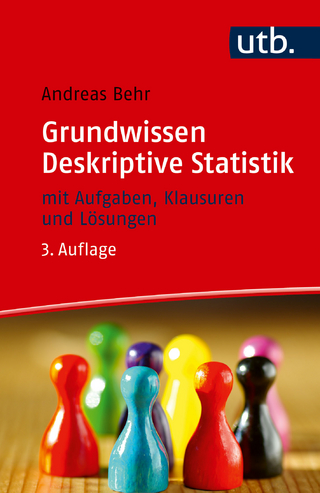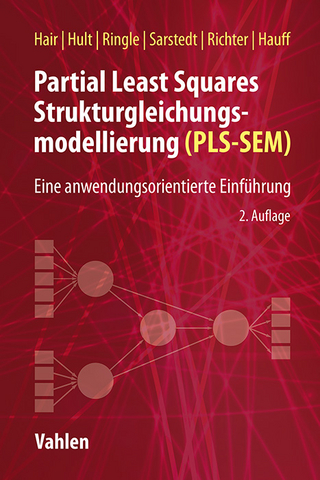
A Course in Econometrics
Harvard University Press (Verlag)
978-0-674-17544-0 (ISBN)
A Course in Econometrics is likely to be the text most thoroughly attuned to the needs of your students. Derived from the course taught by Arthur S. Goldberger at the University of Wisconsin–Madison and at Stanford University, it is specifically designed for use over two semesters, offers students the most thorough grounding in introductory statistical inference, and offers a substantial amount of interpretive material. The text brims with insights, strikes a balance between rigor and intuition, and provokes students to form their own critical opinions.
A Course in Econometrics thoroughly covers the fundamentals—classical regression and simultaneous equations—and offers clear and logical explorations of asymptotic theory and nonlinear regression. To accommodate students with various levels of preparation, the text opens with a thorough review of statistical concepts and methods, then proceeds to the regression model and its variants. Bold subheadings introduce and highlight key concepts throughout each chapter.
Each chapter concludes with a set of exercises specifically designed to reinforce and extend the material covered. Many of the exercises include real microdata analyses, and all are ideally suited to use as homework and test questions.
Arthur S. Goldberger was Professor of Economics, Emeritus, at the University of Wisconsin–Madison.
1. Empirical Relations 1.1 Theoretical and Empirical Relations 1.2 Sample Means and Population Means 1.3 Sampling 1.4 Estimation Exercises 2. Univariate Probability Distributions 2.1 Introduction 2.2 Discrete Case 2.3 Continuous Case 2.4 Mixed Case 2.5 Functions of Random Variables Exercises 3. Expectations: Univariate Case 3.1 Expectations 3.2 Moments 3.3 Theorems on Expectations 3.4 Prediction 3.5 Expectations and Probabilities Exercises 4. Bivariate Probability Distributions 4.1 Joint Distributions 4.2 Marginal Distributions 4.3 Conditional Distributions Exercises 5. Expectations Bivariate Case 5.1 Expectations 5.2 Conditional Expectations 5.3 Conditional Expectation Function 5.4 Prediction 5.5 Conditional Expectations and Linear Predictors Exercises 6. lndependence in a Bivariate Distribution 6.1 Introduction 6.2 Stochastic Independence 6.3 Roles of Stochastic Independence 6.4 Mean-Independence and Uncorrelatedness 6.5 Types of Independence 6.6 Strength of a Relation Exercises 7. Normal Distributions 7.1 Univariate Normal Distribution 7.2 Standard Bivariate Normal Distribution 7.3 Bivariate Normal Distribution 7.4 Properties of Bivariate Normal Distribution 7.5 Remarks Exercises 8. Sampling Distributions Univariate Case 8.1 Random Sample 8.2 Sample Statistics 8.3 The Sample Mean 8.4 Sample Moments 8.5 Chi-square and Student's Distributions 8.6 Sampling from a Normal Population Exercises 9. Asymptotic Distribution Theory 9.1 Introduction 9.2 Sequences of Sample Statistics 9.3 Asymptotics of the Sample Mean 9.4 Asymptotics of Sample Moments 9.5 Asymptotics of Functions of Sample Moments 9.6 Asymptotics of Some Sample Statistics Exercises 10. Sampling Distributions Bivariate Case 10.1 Introduction 10.2 Sample Covariance 10.3 Pair of Sample Means 10.4 Ratio of Sample Means 10.5 Sample Slope 10.6 Variance of Sample Slope Exercises 11. Parameter Estimation 11.1 Introduction 11.2 The Analogy Principle 11.3 Criteria for an Estimator 11.4 Asymptotic Criteria 11.5 Confidence Intervals Exercises 12. Advanced Estimation Theory 12.1 The Score Variable 12.2 Cramer-Rao Inequality 12.3 ZES-Rule Estimation 12.4 Maximum Likelihood Estimation Exercises 13. Estimating a Population Relation 13.1 Introduction 13.2 Estimating a Linear CEF 13.3 Estimating a Nonlinear CEF 13.4 Estimating a Binary Response Model 13.5 Other Sampling Schemes Exercises 14. Multiple Regression 14.1 Population Regression Function 14.2 Algebra for Multiple Regression 14.3 Ranks of X and Q 14.4 The Short-Rank Case 14.5 Second-Order Conditions Exercises 15. Classical Regression 15.1 Matrix Algebra for Random Variables 15.2 Classical Regression Model 15.3 Estimation of beta165 15.4 Gauss-Markov Theorem 15.5 Estimation of delta2 and V(b) Exercises 16. Classical Regression Interpretation and Application 16.1 Interpretation of the Classical Regression Model 16.2 Estimation of Linear Functions of beta13 16.3 Estimation of Conditional Expectation, and Prediction 16.4 Measuring Goodness of Fit Exercises 17. Regression Algebra 17.1 Regression Matrices 17.2 Short and Long Regression Algebra 17.3 Residual Regression 17.4 Applications of Residual Regression 17.5 Short and Residual Regressions in the Classical Regression Model Exercises 18. Multivariate Normal Distribution 18.1 Introduction 18.2 Multivariate Normality 18.3 Functions of a Standard Normal Vector 18.4 Quadratic Forms in Normal Vectors Exercises 19. Classical Normal Regression 19.1 Classical Normal Regression Model 19.2 Maximum Likelihood Estimation 19.3 Sampling Distributions 19.4 Confidence Intervals 19.5 Confidence Regions 19.6 Shape of the Joint Confidence Region Exercises 20. CNR Model Hypothesis Testing 20.1 Introduction 20.2 Test on a Single Parameter 20.3 Test on a Set of Parameters 20.4 Power of the Test 20.5 Noncentral Chi-square Distribution Exercises 21. CNR Model Inference withUnknown 21.1 Distribution Theory 21.2 Confidence Intervals and Regions 21.3 Hypothesis Tests 21.4 Zero Null Subvector Hypothesis Exercises 22. Issues in Hypothesis Testing 22.1 Introduction 22.2 General Linear Hypothesis 22.3 One-Sided Alternatives 22.4 Choice of Significance Level 22.5 Statistical versus Economic Significance 22.6 Using Asymptotics 22.7 Inference without Normality Assumption Exercises 23. Multicollinearity 23.1 Introduction 23.2 Textbook Discussions 23.3 Micronumerosity 23.4 When Multicollinearity Is Desirable 23.5 Remarks Exercises 24. Regression Strategies 24.1 Introduction 24.2 Shortening a Regression 24.3 Mean Squared Error 24.4 Pretest Estimation 24.5 Regression Fishing Exercises 25. Regression with X Random 25.1 Introduction 25.2 Neoclassical Regression Model 25.3 Properties of Least Squares Estimation 25.4 Neoclassical Normal Regression Model 25.5 Asymptotic Properties of Least Squares Estimation Exercises 26. Time Series 26.1 Departures from Random Sampling 26.2 Stationary Population Model 26.3 Conditional Expectation Functions 26.4 Stationary Processes 26.5 Sampling and Estimation 26.6 Remarks Exercises 27. Generalized Classical Regression 27.1 Generalized Classical Regression Model 27.2 Least Square Estimation 27.3 Generalized Least Square Estimation 27.4 Remarks on GL Estimation 27.5 Feasible Generalized Least Squares Estimation 27.6 Extensions of the GCR Model Exercises 28. Heteroskedasticity and Autocorrelation 28.1 Introduction 28.2 Pure Heteroskedasticity 28.3 First-Order Autoregressive Process 28.4 Remarks Exercises 29. Nonlinear Regression 29.1 Nonlinear CEF's 29.2 Estimation 29.3 Computation of the Nonlinear Least Squares Estimator 29.4 Asymptotic Properties 29.5 Probit Model Exercises 30. Regression Systems 30.1 Introduction 30.2 Stacking 30.3 Generalized Least Squares 30.4 Comparison of GLS and LS Estimators 30.5 Feasible Generalized Least Squares 30.6 Restrictions 30.7 Alternative Estimators Exercises 31. Structural Equation Models 31.1 Introduction 31.2 Permanent Income Model 31.3 Keynesian Model 31.4 Estimation of the Keynesian Model 31.5 Structure versus Regression Exercises 32. Simultaneous-Equation Model 32.1 A Supply-Demand Model 32.2 Specification of the Simultaneous-Equation Model 32.3 Sampling 32.4 Remarks 33. Identification and Restrictions 33.1 Introduction 33.2 Supply-Demand Models 33.3 Uncorrelated Disturbances 33.4 Other Sources of Identification Exercises 34. Estimation in the Simultaneous-Equation Model 34.1 Introduction 34.2 Indirect Feasible Generalized Least Squares 34.3 Two-Stage Least Squares 34.4 Relation between 2SLS and Indirect-FGLS
| Erscheint lt. Verlag | 2.7.1991 |
|---|---|
| Zusatzinfo | 32 line illustrations, 9 tables |
| Verlagsort | Cambridge, Mass |
| Sprache | englisch |
| Maße | 156 x 235 mm |
| Gewicht | 599 g |
| Themenwelt | Wirtschaft ► Volkswirtschaftslehre ► Ökonometrie |
| ISBN-10 | 0-674-17544-1 / 0674175441 |
| ISBN-13 | 978-0-674-17544-0 / 9780674175440 |
| Zustand | Neuware |
| Haben Sie eine Frage zum Produkt? |
aus dem Bereich


